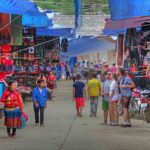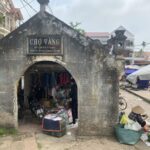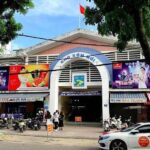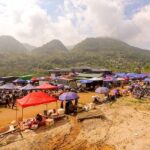A Journey to the Market
Sin Cheng Market is located in the heart of Sin Cheng Commune, Si Ma Cai District, Lao Cai Province – about 80km from Lao Cai City via National Highway 70. From Lao Cai City, the journey to the market passes through Bac Ha town, then continues to the center of Si Ma Cai town. From there, it’s just a 10km journey to reach the weekly Wednesday market.
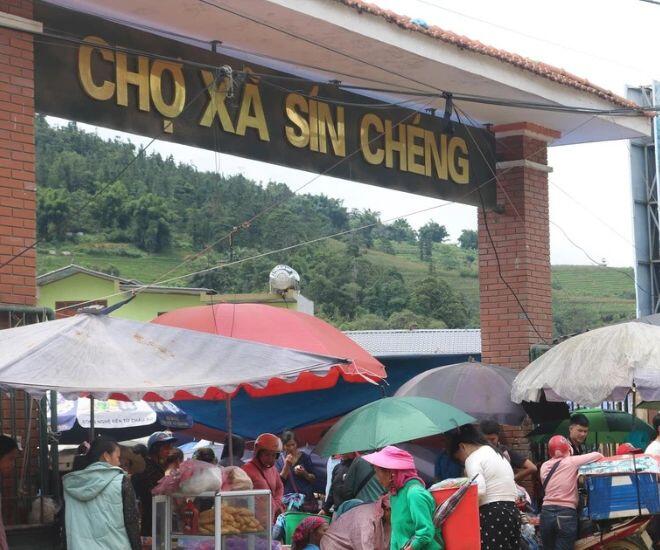
The route to Sin Cheng is rugged yet picturesque, passing through lush terraced rice fields, towering mountains, and small ethnic minority villages nestled in the mountain slopes. As you get closer to the market, the atmosphere becomes livelier with groups of people carrying goods, leading horses, and bringing local specialties to the market from the early morning.
A Unique Trading Space in the Mountains
Sin Cheng Market is likened to a “living museum” of mountain life. Here, the goods on offer are not only diverse but also bear the strong imprint of the region: from agricultural products, livestock, and fabrics to handcrafted items such as brooms, baskets, knives, and sickles. All of these products are made by the skillful hands of the Mong, Dao, Nung, and Phu La ethnic groups.
At the entrance of the market, the unique choi mia nuong (sugarcane brooms) catch the eye of many visitors. Made from local sugarcane plants grown on rice and corn fields, each broom is a meticulous handicraft, with a carefully woven handle that takes about an hour to complete. Locals shared that these brooms are priced at about 50,000 VND each but are highly durable and favored by many customers. On busy market days, some sellers can sell up to 50 brooms.
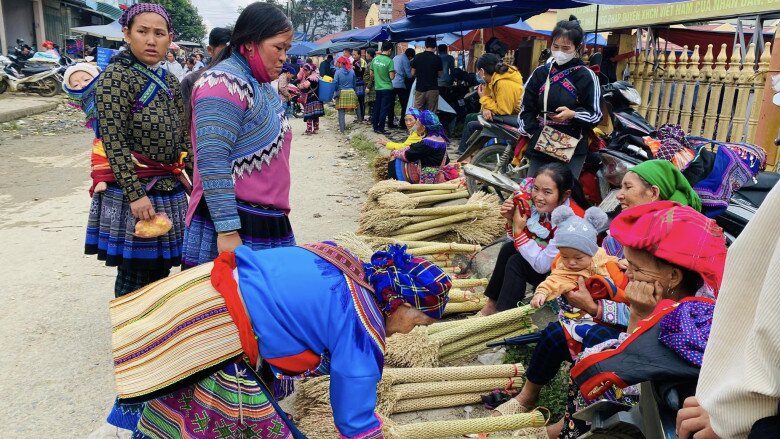
In addition to brooms, the market also offers hoa mi (songbirds), lon cap nach (piglets carried under the arm), local black chickens, cattle, horses, and various vegetables such as bell peppers, wrinkled chili peppers, eggplants, star anise, and pumpkins. These products are all organic, grown and raised by the locals, and brought directly to the market without any intermediaries.
Cuisine and Cultural Depth
Sin Cheng Market is also a unique culinary destination in the highlands. It’s not uncommon to see groups of people gathering around a bowl of steaming pho (rice noodle soup), a cup of strong corn wine, or a dish of men men tron com – a characteristic dish of the Mong people. Men men is made from ground corn, steamed, and then mixed with white rice, carrying the simple yet hearty flavors of the mountains.
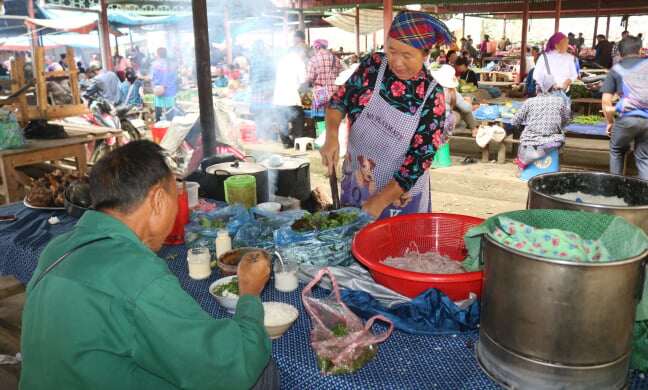
Once upon a time, men men was the main dish of the Mong people during their impoverished years. Although life has improved and transportation has become more convenient, doing away with the need for horse-carriage deliveries to the market, men men tron com remains an integral part of the highland culinary culture.
In addition to men men, the market also offers various specialties such as thang co (a traditional stew of internal organs), pho ngua (horse noodle soup), steamed meat with la mac mat (a type of leaf), and grilled rice cakes, attracting both locals and domestic and foreign tourists seeking the authentic flavors of the Northwest.
A Gathering of Culture and People
The market is not just a place for trading goods but also a vibrant cultural space. It is a place for long-lost friends to reunite and share business experiences, and an opportunity for young men and women to meet and make new friends – a custom still maintained in many Mong and Dao villages.
The colorful costumes, the sound of flutes and panpipes echoing through the market, and the lively conversations over cups of wine all come together to form a vibrant picture of mountain life.
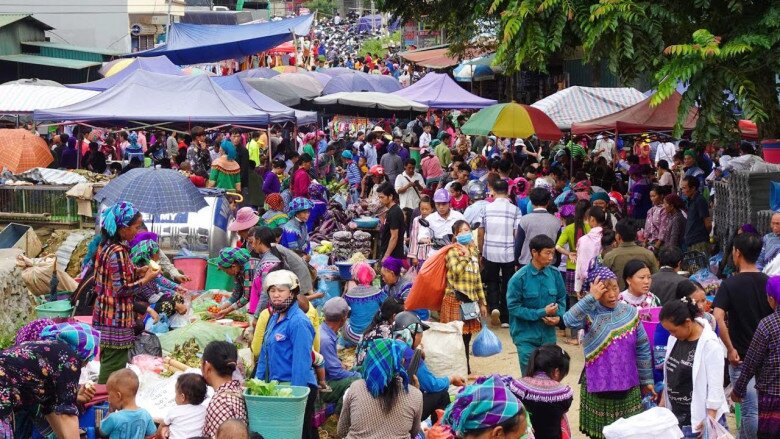
The locals consider the market day as a grand festival. They carefully prepare their outfits, products, and their best attitudes. For visitors, the market is a profound cultural experience – a natural and unadorned blend of people, nature, and traditions.
Preserving Traditional Beauty in a New Context
Sin Cheng Market was officially established after 2000 when the state invested in building infrastructure for the commune center. Since then, the market has been regularly held every Wednesday, growing in scale and appeal.
To ensure security, environmental sanitation, and the aesthetic appearance of the market, Sin Cheng Commune has established a market management team responsible for propaganda, inspection, and guidance for traders to comply with the regulations. This effort is crucial in maintaining the efficiency and sustainability of the market in the context of an expanding market economy.
The presence of Sin Cheng Market over the past two decades has brought about significant benefits: increasing local incomes, promoting local tourism, and most importantly, preserving ethnic cultural values in modern life.
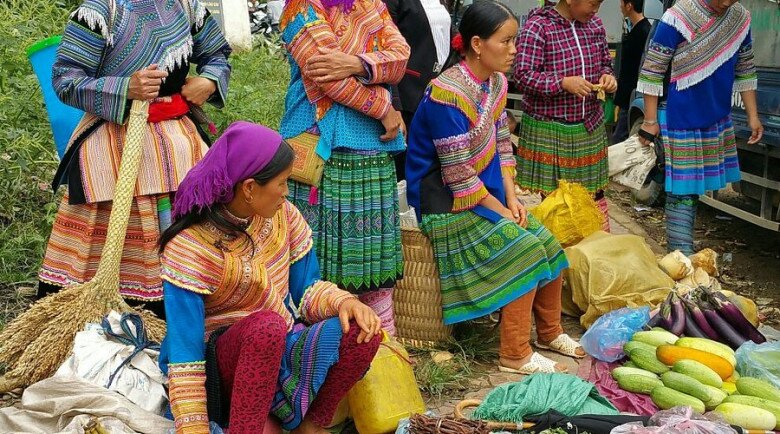
For many tourists, Sin Cheng Market is a must-visit destination when exploring the Northwest highlands. The market space offers an authentic and unpretentious experience, free from excessive commercialization. The vibrant Mong skirts, the fresh produce from the fields, the sincere smiles, and the firm handshakes – all of these elements come together to create lasting memories of the market.
Sin Cheng Market is not just a place of commerce but also an epic of highland culture, where every person and every product carries a unique story – of labor, kinship, livelihood, and ethnic pride.
Lost in a Colorful Market in the Heart of Hoa Binh, This Becomes the Ultimate Attraction in Mai Chau
Nestled in the heart of Mai Chau, the Pa Co Sunday Market is more than just a hub of commerce – it’s a vibrant tapestry of Hmong culture. Every Sunday morning, the market comes alive with a bustling array of vendors and shoppers, offering a unique glimpse into the traditions and way of life of the highland Hmong people.
The Dawn of a Unique Buffalo Market in Lao Cai: A Pitch-Black Herd at Dawn
The Can Cau Cattle Market is a captivating destination in Lao Cai Province. This vibrant market is renowned for its lively trade of hundreds of cattle, brought by locals from distant villages. The scene is a kaleidoscope of colors, with Hmong and Giay youths gracefully flocking to the market, creating a unique and enchanting atmosphere in this far-flung border region.

























